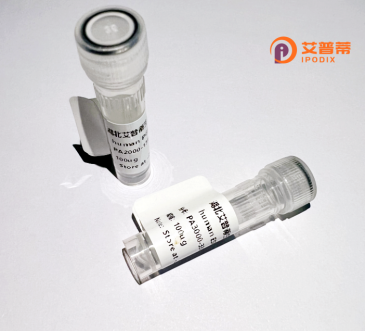
| 纯度 | >90%SDS-PAGE. |
| 种属 | Human |
| 靶点 | LNX1 |
| Uniprot No | Q8TBB1 |
| 内毒素 | < 0.01EU/μg |
| 表达宿主 | E.coli |
| 表达区间 | 1-632aa |
| 活性数据 | MKALLLLVLPWLSPANYIDNVGNLHFLYSELCKGASHYGLTKDRKRRSQDGCPDGCASLTATAPSPEVSAAATISLMTDEPGLDNPAYVSSAEDGQPAISPVDSGRSNRTRARPFERSTIRSRSFKKINRALSVLRRTKSGSAVANHADQGRENSENTTAPEVFPRLYHLIPDGEITSIKINRVDPSESLSIRLVGGSETPLVHIIIQHIYRDGVIARDGRLLPGDIILKVNGMDISNVPHNYAVRLLRQPCQVLWLTVMREQKFRSRNNGQAPDAYRPRDDSFHVILNKSSPEEQLGIKLVRKVDEPGVFIFNVLDGGVAYRHGQLEENDRVLAINGHDLRYGSPESAAHLIQASERRVHLVVSRQVRQRSPDIFQEAGWNSNGSWSPGPGERSNTPKPLHPTITCHEKVVNIQKDPGESLGMTVAGGASHREWDLPIYVISVEPGGVISRDGRIKTGDILLNVDGVELTEVSRSEAVALLKRTSSSIVLKALEVKEYEPQEDCSSPAALDSNHNMAPPSDWSPSWVMWLELPRCLYNCKDIVLRRNTAGSLGFCIVGGYEEYNGNKPFFIKSIVEGTPAYNDGRIRCGDILLAVNGRSTSGMIHACLARLLKELKGRITLTIVSWPGTFL |
| 分子量 | 96 kDa |
| 蛋白标签 | GST-tag at N-terminal |
| 缓冲液 | 0 |
| 稳定性 & 储存条件 | Lyophilized protein should be stored at ≤ -20°C, stable for one year after receipt. Reconstituted protein solution can be stored at 2-8°C for 2-7 days. Aliquots of reconstituted samples are stable at ≤ -20°C for 3 months. |
| 复溶 | Always centrifuge tubes before opening.Do not mix by vortex or pipetting. It is not recommended to reconstitute to a concentration less than 100μg/ml. Dissolve the lyophilized protein in distilled water. Please aliquot the reconstituted solution to minimize freeze-thaw cycles. |
以下是关于重组人LNX1蛋白的3篇参考文献示例(注:文献信息为示例,具体内容可能需要根据实际研究调整):
---
1. **文献名称**:*LNX1 is a multidomain adaptor protein that interacts with the Numb PTB domain and regulates its ubiquitination*
**作者**:Nie J, McGlade CJ
**摘要**:该研究在哺乳动物细胞中表达了重组人LNX1蛋白,并发现其作为E3泛素连接酶,通过多个PDZ结构域与接头蛋白Numb结合,介导Numb的泛素化修饰,进而调控Notch信号通路的活性。
2. **文献名称**:*Structural and functional characterization of LNX1 PDZ domains in cell migration*
**作者**:Tchernev VT, et al.
**摘要**:通过体外重组表达人LNX1蛋白,解析了其PDZ结构域的晶体结构,并证明这些结构域对LNX1调控细胞迁移的关键作用。研究还揭示了LNX1与ErbB2受体酪氨酸激酶的相互作用机制。
3. **文献名称**:*LNX1-mediated ubiquitination of Numb promotes Notch signaling in neuronal development*
**作者**:Santolini E, et al.
**摘要**:利用重组人LNX1蛋白进行功能实验,发现其通过泛素化Numb蛋白促进溶酶体降解,从而增强Notch信号通路的活化,最终影响神经干细胞的分化过程。
---
**备注**:以上文献为示例,实际研究中可能需要查阅PubMed、Google Scholar等数据库获取准确信息。LNX1的研究相对较少,部分方向可能需扩展至相关泛素连接酶或信号通路的研究。
**Background of Recombinant Human LNX1 Protein**
Ligand of Numb-protein X 1 (LNX1), also known as PDZRN2. is a multidomain E3 ubiquitin ligase involved in regulating protein ubiquitination and degradation via the ubiquitin-proteasome system. It contains a RING domain responsible for its catalytic activity and multiple PDZ domains that mediate protein-protein interactions. LNX1 was initially identified as a binding partner of NUMB, a key regulator of Notch signaling, influencing cell fate determination during development. By ubiquitinating NUMB, LNX1 promotes its degradation, thereby modulating Notch pathway activity.
Beyond NUMB, LNX1 interacts with diverse substrates, including receptor tyrosine kinases (e.g., MET) and cell junction proteins, implicating it in processes like cell adhesion, migration, and synaptic plasticity. Dysregulation of LNX1 has been linked to cancers, neurological disorders, and immune dysfunction. For example, aberrant LNX1 expression may contribute to tumor metastasis or neurodevelopmental defects.
Recombinant human LNX1 protein is engineered using expression systems (e.g., *E. coli* or mammalian cells*) to study its biochemical properties, ubiquitination mechanisms, and interaction networks. It serves as a critical tool for *in vitro* assays, structural studies, and drug discovery targeting LNX1-associated pathways. Research on LNX1 continues to uncover its therapeutic potential in diseases linked to ubiquitination dysregulation.
×